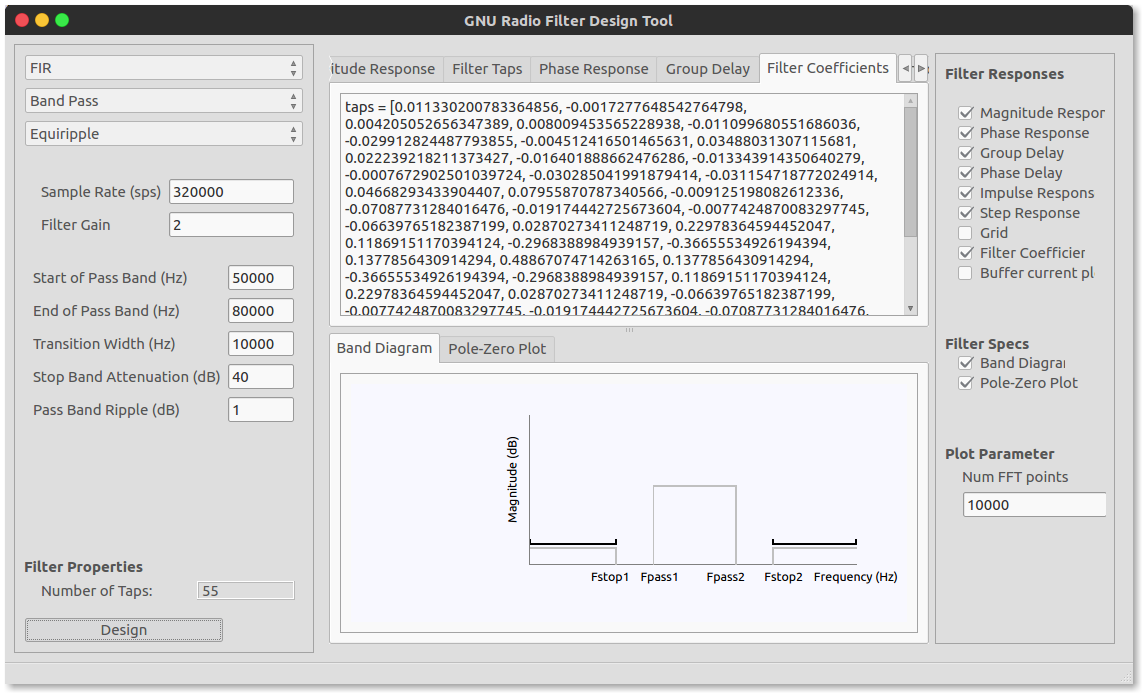

These connections are basically connecting your power supply to the different Vdd (logic/digital supply) and AVdd (analogue supply) pins as well as the GND of the power source. The dsPIC33E needs some components and connections in order for it to function as described in the datasheet: In this section, we will review all the essential connections the dsPIC33E needs to work properly and some other design advice for implementation. If you are implementing a different device, please check its datasheet and product information as there might be some minor differences.
#DSPIC FILTER DESIGNER CODE#
#DSPIC FILTER DESIGNER HOW TO#
In this article, we will learn how to make your first design of an electronic device with the dsPIC33E.

They also created a nice DSP library that makes life a lot easier when implementing DSP operations such as digital filters, Fourier transforms and automatic gain control. They integrated all the well-known features of the PIC MCUs with the horsepower and architecture required to perform complex mathematical operations in real time.

Microchip created its own family of these devices and baptized them as dsPICs.

It’s extensive community, cheap price and versatility made it a very attractive option for first timers in the world of embedded electronics.Īs MCUs became more powerful, and the industry demanded more from them, manufacturers came up with ideas such as integrating an MCU with special hardware and functions to perform real-time digital signal processing. 1) External crystal with internal MCU oscillator circuitīefore the Arduino, Microchip PICs were the microcontroller of choice for many hobbyists and makers.In the end, the choice of the microcontroller comes down to the specifics of the application and the familiarity the programmer has with the MCU. There are many microcontrollers’ manufacturers and architectures in the market, some that are most common in the market and the “student and hobbyist” sector are:Įach different type has its own pros and cons, and some of them are very similar as well. It contains a CPU, memory, I/O pins and peripherals, all in a single package. A microcontroller is basically a computer shrunk to a chip. In order to control, process, easily change parameters of the design on demand and keep the design tidy and relatively low complexity, it is unpractical to approach a solution using purely discrete analogue and digital components.įor this reason, a natural choice is the use of a microcontroller. If you are designing an electronic product, chances are that it will have a microcontroller (MCU) embedded into it. The maximum sampling frequency depends on the length of processing (filter order) and selected clock.This is a guest post by Roberto Weiser of Developpa.io. As the order of the filter increases, the selectivity of the filter will be higher (narrower transition zone), but the complexity of the filter will increase as a consequence of the more memory required for storing the samples and longer processing. This does not apply if Kaiser window function is applied, when on the basis of the selected parameters the order of filter is selected automatically. Then, the order of the filter is selected. In the part Filter settings the type of filter is selected first: Of course, one never selects the minimum frequency, thus in this case the sampling frequency of at least 10kHz should be selected. the input signal is in the range 100Hz – 4400Hz, the minimum sampling frequency is 8800Hz. The sampling frequency has to be at least twice as high as the maximum frequency of the input signal. In the part Input Signal, two parameters, sampling frequency and input channel of the AD converter, should be selected. In the part Device setup appear the clock and designation of the used microcontroller.


 0 kommentar(er)
0 kommentar(er)
